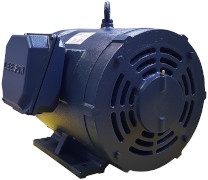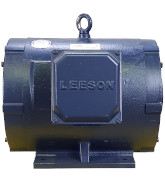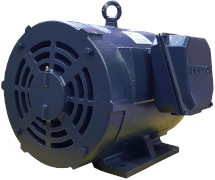What is a Rotary Phase Converter Generator?



Rotary phase converters create the 3rd electrical phase by using a specially designed rotary generator.
Some rotary phase converters simply use a regular 3-phase motor, also known as an idler motor for rotary phase converter. Many 3 phase motors, when used as a generator, will have their output voltage collapse when placed under load. Having a properly sized and engineered rotary generator will help ensure you have a proper voltage balance.
The rotary generator is the single most important investment in the rotary phase converter. We have built and serviced rotary phase converters for 35 years. Since the generator is such a crucial component, we have dialled in the exact specifications that work best for maintaining a quality 3 phase output. We have these generators custom-built.
How to Compare Rotary Phase Converter Generators
Since the rotary generator is such an important component of the rotary phase converter, it is important to understand how to compare them from one manufacture to another. To determine how to size a rotary phase converter, the main consideration is if it has enough capacity to run the motor loads. A rotary phase converter will list two motor load sizes: total motor horsepower and largest motor horsepower.
The largest horsepower rating of a rotary phase converter will tell you the largest motor that it can start before the generator's voltage collapses. The hardest part about running a 3 phase machine is starting it. Once running, it requires far fewer amps to keep it going. This is why the total motor horsepower can be larger than the largest motor it can start.
There is no governing body to determine a phase converter's size. This means a rotary converter manufacturer can claim whatever they want about the capacity ratings of their unit. Rotary generators, however, do have standardized sizing. The Frame size of the generator tells you its size and allows you to compare it across other brands. This is the most reliable method is to compare rotary phase converter capacities.
Frame Size - Bigger is Better
The rotary generator needs to be large enough to start your motor. A 3 phase generator or phase converter has a limitation as to the largest motor allowable on the system. When you turn on your 3 phase motor, it will place a load on the rotary generator. If you have a big generator then it will keep on spinning when you add on the load. However, if the generator is too small then it will slow down and possibly stall out as it tries to start your motor. The more mass your generator has, the bigger the “punch” it can deliver when you turn on your motor.
To compare generator sizes, look at its frame size. This is a standardized measurement system. A generator with a frame size of 256T is bigger than a 254T. If this information is not readily available, the shipping weight will provide a decent proxy because a heavier rotary converter will have a larger rotary generator.
Generator Frame Sizese for PhaseMaxx Rotary Phase Converters
| Models | Largest HP | Total HP | Generator Frame Size |
Generator Weight |
|---|---|---|---|---|
| Phase Maxx 3T | 3 HP | 9 HP | 213T | 154 lbs. |
| Phase Maxx 5T | 5 HP | 15 HP | 215T | 172 lbs. |
| Phase Maxx 7TZ | 7 HP | 22 HP | 254T | 254 lbs. |
| Phase Maxx 10TZ | 10 HP | 30 HP | 256T | 312 lbs. |
| Phase Maxx 15TZ | 15 HP | 45 HP | 286T | 376 lbs. |
| Phase Maxx 20TZ | 20 HP | 60 HP | 324T | 489 lbs. |
Voltage Drop and Reduced Starting Torque
What is important to note, is that an electric motor that experiences a 10% drop in voltage will have an approximate 19 - 23% loss of starting torque. A rotary converter that is sized too small for a particular motor will not allow the motor to develop the required load starting torque, and it will be unable to reach its rated speed. The larger an electric motor is the higher its starting current will be, and the more it will collapse the converter generated voltage.
Have Questions?
Talk to one of our Journeymen Electricians
Contact Us


